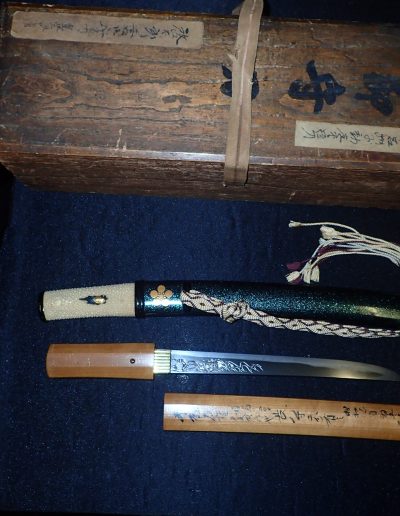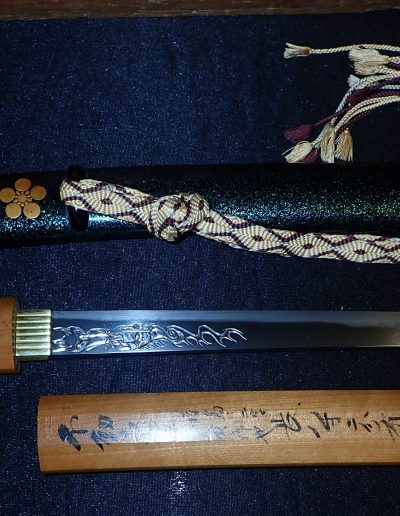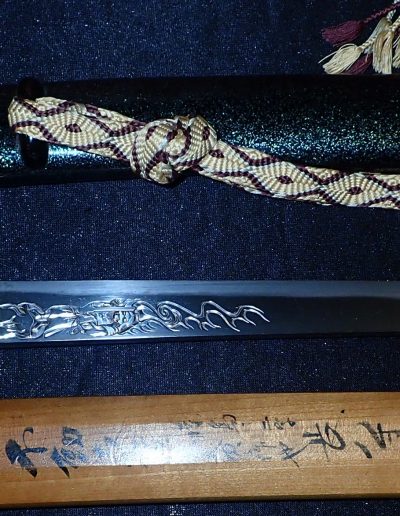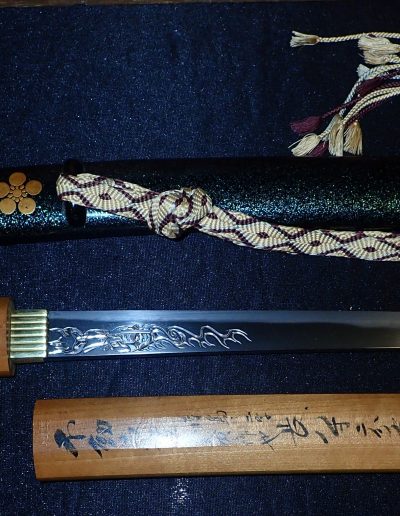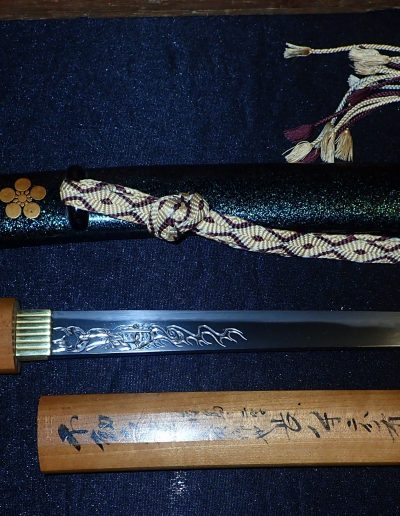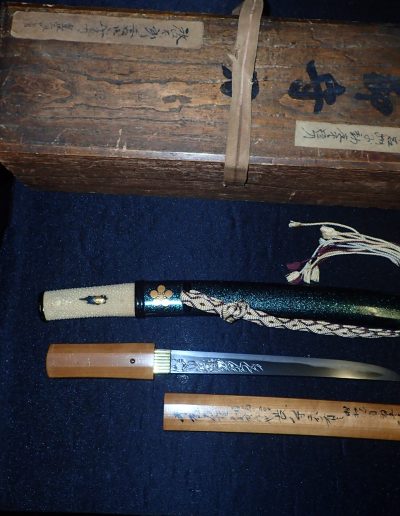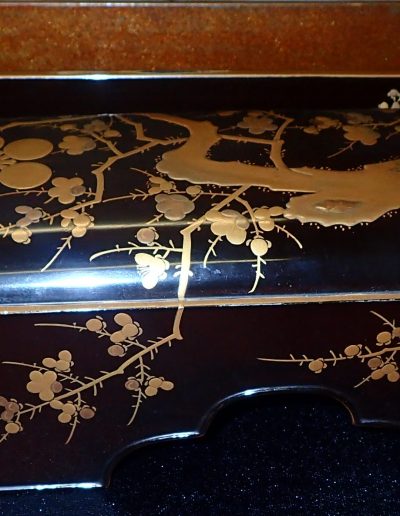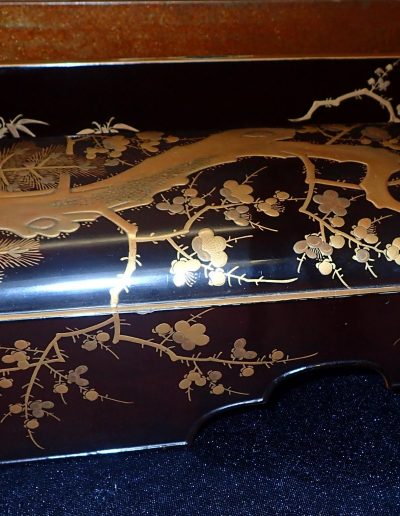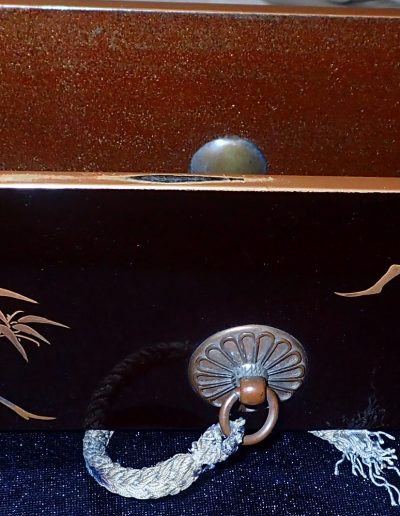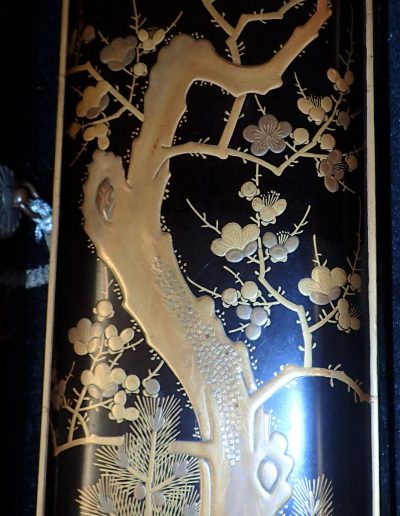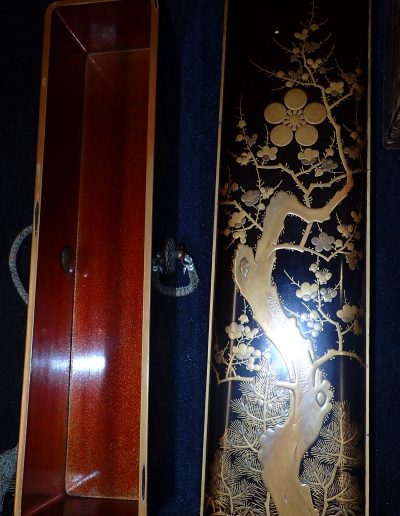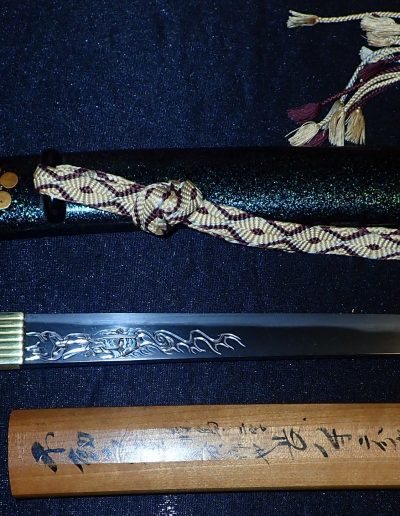Very Rare Historically important tanto owned by Maeda Daimyo Tanto With NBTHK Tokubetsu Hozon Certificate in original wooden storage box with inner makie lacquered box with Maeda Mon on the lid . Koshirae also has Maeda mon on the saya and Kashira, excellent kozuka with Hou bird / Phoenix signed Goto Misuhisa, Kogatana has very fine horimono .Very well forged blade with active hamon with loads of hataraki and Great Horimono of Fudo.
NBTHK Tokubetsu Hozon Certificate
KANTEI-SHO (鑑定書) ‒ APPRAISAL
No 1001416
Tantō, signed: Tomoshige (友重) (Fujishima, 藤島)
Nagasa ~ 24.9 cm
According to the result of the shinsa committee of our society, we judge this work as authentic
and rank it as Tokubetsu-Hozon Tōken.
June 28, 2013
[Foundation] Nihon Bijutsu Tōken Hozon Kyōkai, NBTHK (⽇本美術⼑劍保存協會
Sayagaki on Shirasaya by Kanzan Sato Sensei
不動友重
藤島之⼆字
天⽂頃之作也
⻑⼋⼨⼆分有之
昭和⼰⾣初冬
寒⼭誌「花押」
Fudō Tomoshige
Fujishima kore niji
Tenbun goro no saku nari
Nagasa hassun ni-bu kore ari
Shōwa tsuchinoto-tori shotō
Kanzan shirusu + kaō
Fudō Tomoshige [Reference to engraving of deity Fudō-Myōō]
Fujishima [smith], signed two characters. Tomoshige.
Work from around Tenbun (1532-1555).
Blade length ~ 24.9 cm
Written by Kanzan in October of the year of the rooster of the Shōwa era (1969) + monogram
Ink inscription of wooden storage box:
御守⼑
Omamori-gatana
“Protective sword”
Tag on top right of box:
前⽥家傳来名物不動友重短⼑
Maeda-ke denrai meibutsu Fudō Tomoshige tantō
“Famous tantō that was handed down within the Maeda family as Fudō Tomoshige”
Tag on bottom left of box:
哲太郎君御守⼑ 寛政⼗⼆庚申⼆⽉
Tetsutarō-kimi omamori-gatana, Kansei jūni kanoe-saru nigatsu
“Protective sword of Tetsutarō, second month of Kansei twelve (1800), year of the monkey.”
Tag on side of box:
⼑之部
第百⼋⼗⼀号
ロ⼗七番
Katana no bu
Dai hyakuhachijūichi gō
Ro jūshichi-ban
“Sword section
Nr. 181–B17
Maeda Toshiyasu (前田 利保, March 23, 1800 – September 14, 1859) was the 10th daimyō of Toyama Domain in the Hokuriku region of Japan, and a noted Japanese naturalist and entomologist.
Toshiyasu was born in Edo as Keitaro (啓太郎), the second son of Maeda Toshinori, but was still underage on his father’s death, so the domain was assigned to Maeda Toshitsuyo instead. In 1811, he was adopted by Toshitsuyo to restore the line of succession and became daimyō in 1835 when Toshitsuyo retired due to illness. On taking office, the domain was hit hard by a crop failure, which continued through 1838 as part of the Tenpō famine. The domain defaulted on all its debts, and was forced to take a 30,000 ryō loan from the shogunate in 1838, followed by an additional 25,000 ryō the following year. In 1841, the domain reported that it did not have the funds to make its required sankin kōtai to Edo. In 1846, citing ill heath, Toshiyasu went into retirement in favor of his sixth son, Maeda Toshitomo. His wife was a daughter of Asano Narikata of Hiroshima Domain.
Along with Kuroda Narikiyo of Fukuoka Domain, he was also a noted scientist, and organised a society of naturalists which met each month. An account was written of the subject discussed, for instance, in September 1840 they discussed the beetle family Scarabaeidae and wrote Kyōro-shakō-zusetsu in which twenty chafer species are scientifically drawn and described. As these studies were refined each member of the group became a specialist. Maeda learned the Dutch language (the Japanese naturalists followed Philipp Franz von Siebold and also learned the French language Siebold’s choice for Fauna Japonica and Flora Japonica) and translated the Dutch language Systema Naturae into Japanese. He is also noted for authoring the Honzō Tsūkan, an encyclopaedia of Chinese medicinal herbs, which remained uncompleted in 94 volumes at the time of his death.


